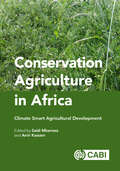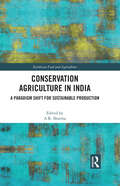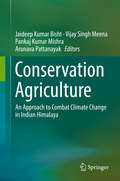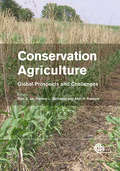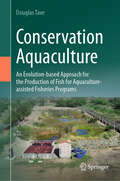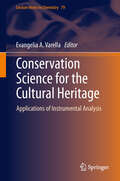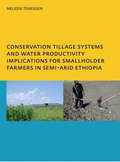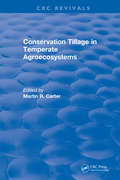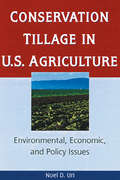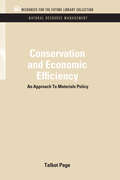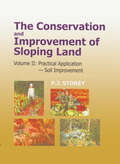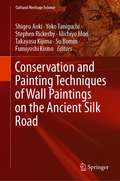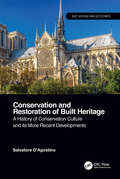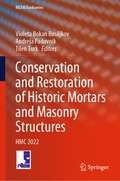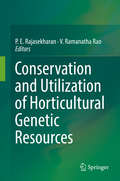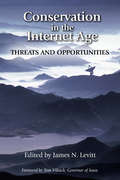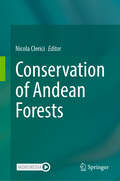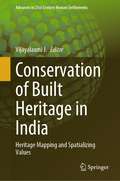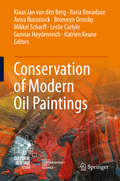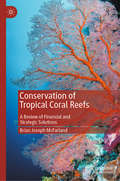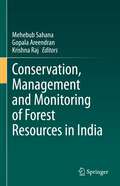- Table View
- List View
Conservation Agriculture in Africa: Climate Smart Agricultural Development
by Neil Miller Richard Bell Patrick Gicheru Trent W Bunderson Zwide D Jere Josef Kienzle Erna Kruger Peter Kuria Simon Lugandu Weldone Mutai Brian G. Sims Hendrik J. Smith Christian Thierfelder Reynolds K. Shula Johann Strauss Joseph Mureithi Mohamed Annabi Haithem Bahri Mloza Banda Gotlieb Basch Alexandra Bot Martin Bwalya Hatem Cheikh M’hamed Cornelius Chiduza Cary Clark Demba Diakhaté Mazwi Dlamini Sjoerd Duiker Alioune Fall Aymen Frija Josiah Gitari Tom Goddard Emilio Gonzalez-Sanchez Isaac Gura Enamul Haque Michel Havard Zied Idoudi Mohammad Jahiruddin Onesmos Kitonyo Phlorentin Philip Lagwen Ngari Macharia Temakholo Mathebula Sixolise Mcinga Alfred Micheni Frank Mmbando Rachid Moussadek Pearson Nyari Mnkeni Rachid Mrabet Ndabhemeye Mulengera Walter Mupangwa R. M. Museka Munyaradzi Mutenje Lindah Muzangwa Remmy Mwakimbwala Andre A Nel James Njeru Rama Ngatoluwa Phumzile Ngcobo Isaiah Nyagumbo Putso Nyathi Ricardo Ralisch Leonard Rusinamhodzi John Sariah Ibrahima Sarr Peter Setimela Richard Shetto Dimas Soares Júnior Peter Steward Gerhardus Trytsman Jean Twilingiyumukiza Carl Wahl Peter Waweru Nouhoun ZampaligreTillage agriculture has led to widespread soil and ecosystem degradation globally, and more particularly in the developing regions. This is especially so in Africa where traditional agricultural practices have become unsustainable due to severe exploitation of natural resources with negative impacts on the environment and food system. In addition, agricultural land use in Africa today faces major challenges including increased costs, climate change and a need to transform to more sustainable production intensification systems. Conservation Agriculture has emerged as a major alternative sustainable climate smart agriculture approach in Africa and has spread to many African countries in the past decade as more development and research, including in sustainable mechanization, has enabled its extension and uptake. It is key to transforming Africa's agriculture and food system given its ability to restore soil health, biodiversity and productivity of millions of smallholder farms as well as larger-scale farms. This landmark volume is based on the material presented at the Second Africa Congress on Conservation Agriculture which was held in Johannesburg, South Africa, 9-12 October 2018. The main theme of the Congress was 'Making Climate Smart Agriculture Real in Africa with Conservation Agriculture: Supporting the Malabo Declaration and Agenda 2063'. The Congress was aligned to mobilize stakeholders in all agriculture sectors to provide greater technical, institutional, development and investment support, impetus and direction to the vision and agenda for transforming African agriculture as set out by the Malabo Declaration and Agenda 2063. This book is aimed at all agricultural stakeholders in the public, private and civil sectors in Africa engaged in supporting the transformation of conventional tillage agriculture to Conservation Agriculture. The book will be of interest to: researchers, academics, students, development stakeholders, public and private sector investors and policy makers as well as institutional libraries across the world.
Conservation Agriculture in India: A Paradigm Shift for Sustainable Production (Earthscan Food and Agriculture)
by A. R. SharmaThis book examines the current situation, levels of adoption, management practices, and the future outlook of conservation agriculture in India, and also in other tropical and subtropical regions of the world. While conservation agriculture is proposed as an important means to combat climate change, improve crop productivity and food affordability, and to protect the environment, the adoption of conservation agriculture in India, and south-east Asia more broadly, has been slow. This volume reflects on the current status of conservation agriculture in India, asking why adoption has been slow and putting forward strategies to improve its uptake. The chapters cover the various aspects of crop management such as soil, water, nutrients, weeds, crop residues, machinery, and energy, in a range of environments, including irrigated and rainfed regions. The impact of climate change and the economic considerations behind the adoption of conservation agriculture are also discussed. The volume concludes by discussing the future outlook for conservation agriculture in India, in particular drawing out parallels with other tropical and subtropical regions of the world. This book will be of great interest to students and scholars of conservation agriculture, sustainable agriculture, crop and soil management, and environmental and natural resource management.
Conservation Agriculture: An Approach to Combat Climate Change in Indian Himalaya
by Jaideep Kumar Bisht Vijay Singh Meena Pankaj Kumar Mishra Arunava PattanayakThis book showcases a compilation of case studies presented by scientists, teachers and academics and covers contemporary technologies for combating climate change, including sustainable agricultural management practices and conservation agriculture. It highlights the situations that future generations in the Indian Himalayas will face, and addresses the major challenges for tomorrow's generations in their efforts to ensure sufficient food production for the global population. It also sheds light on the factors that are routinely ignored in connection with agricultural management practices for sustainable food production and risk assessment. Lastly, it illustrates the need to develop a comprehensive master plan for strategic planning, including conservation agriculture practices that address poverty and food security in the wake of climate change impacts.
Conservation Agriculture: Conservation Agriculture for Sustainable Agriculture
by Ashok K. Patra Ram C. Dalal Somasundaram Jayaraman Suresh K. ChaudhariFeeding the increasing global population, which is projected to reach ~10 billion by 2050, there has been increasing demands for more improved/sustainable agricultural management practices that can be followed by farmers to improve productivity without jeopardizing the environment and ecosystem. Indeed, about 95% of our food directly or indirectly comes from soil. It is a precious resource, and sustainable soil management is a critical socio–economic and environmental issue. Maintaining the environmental sustainability while the world is facing resource degradation, increasing climate change and population explosion is the current challenge of every food production sectors. Thus, there is an urgent need to evolve a holistic approach such as conservation agriculture to sustain higher crop productivity in the country without deteriorating soil health. Conservation Agriculture (CA), is a sustainable approach to manage agro–ecosystems in order to improve productivity, increase farm profitabilty and food security and also enhance the resource base and environment. Worldwide, it has been reported various benefits and prospects in adopting CA technologies in different agro-climatic conditions. Yet, CA in arid and semi-arid regions of India and parts of south Asia raises uncertainities due to its extreme climates, large scale residue burning, soil erosion and other constraints such as low water holding capacity, high potential evapotranspiration, etc . Thus, the proposed book has 30 chapters addressing all issues relevant to conservation agriculture/no-till farming system. The book also gives further strengthening existing knowledge in relation to soil physical, chemical and biological processes and health within close proximity of CA as well as machinery requirements. Moreover, the information on carbon (C) sequestration, C credits, greenhouse gas (GHG) emission, mitigation of climate change effects and socio-economic view on CA under diverse ecologies namely rainfed, irrigated and hill eco-region is also deliberated. For large scale adoption of CA practices in South Asian region especially in India and other countries need dissemination of best-bet CA technologies for dominant soil types/cropping systems through participatory mode, strong linkages and institutional mechanism and public-private-policy support.We hope this book gives a comprehensive and clear picture about conservation agriculture/no-till farming and its associated problem, challenges, prospects and benefits. This book shall be highly useful reference material to researchers, scientists, students, farmers and land managers for efficient and sustainable management of natural resources.
Conservation Agriculture: Global Prospects and Challenges
by Amir KassamThe book covers the spread of conservation agriculture (CA) to regions including Brazil, Argentina, Canada, Australia, Europe and emerging CA destinations in Asia and Africa. Topics covered include the various components of CA, and how their individual and combined implementation influence productivity, soil health and environmental quality under diverse edaphic and climatic conditions. The book will be useful to teachers, researchers, extensionists, farmers, and students interested in environmental quality.
Conservation Aquaculture: An Evolution-based Approach for the Production of Fish for Aquaculture-assisted Fisheries Programs
by Douglas TaveStocking hatchery-produced fish has been a standard component of fisheries management for over 100 years. This book discusses the production of hatchery fish used in aquaculture-assisted fisheries programs to help stabilize and recover endangered species. For the most part, these programs have been unsuccessful, and a reason why is that the traditional approach to fish culture produces fish that are genetically and behaviorally ill-suited to help recover an imperiled species. The hatchery environment and management used to culture the fish makes them sub-viable in the wild. Even if most of the augmented fish die, survivors that mate with wild fish lower the fitness of the endangered population, making the conservation program counter-productive. Since traditional aquaculture programs have been shown to produce fish that are ill-suited to help recovery, a new way of producing fish is needed. That new way is conservation aquaculture. In conservation aquaculture, fish are raised in naturalized mesocosms that mimic the environment in which the endangered species lives. Management is naturalized, so domestication does not produce genetic changes, and so fish develop a full and effective suite of behaviors that enable them to forage efficiently and detect and avoid predators when stocked. The conservation aquaculture management techniques described in the book can also be used to improve commercial and recreational fish stocking programs.
Conservation Practices in Museums: For Researchers and Museum Professionals
by Nobuyuki KambaThe author introduces conservation science and management of cultural heritages in museums. In particular, a comprehensive conservation study and practical techniques are described. Aspects such as examination and diagnosis of cultural heritage by scientific data recording of humidity, luminosity, intensity of vibration and shock, among others, are introduced. Preventive and remedial conservation with X-ray imaging and X-ray fluorescence and other risk-control methods are also explained. The author provides basic theories based on a scientific view for the methods introduced in this book. They can be compared with those used at other museums, and readers can employ them to adapt and improve their methods. Today, maintaining smooth internal communication is key for scientists and curators with different academic backgrounds and from different departments working together on conservation projects at the museum.The author addresses the current global trend of preserving rather than repairing cultural heritage at museums and emphasizes its importance.
Conservation Science for the Cultural Heritage: Applications of Instrumental Analysis (Lecture Notes in Chemistry #79)
by Evangelia A. VarellaConservation Science is a rather innovative application of instrumental analysis with steadily increasing importance. Although the first attempts for preserving material from the cultural heritage on a scientific basis are found in the 19th century pioneer chemistry years, only the use of sophisticated physicochemical techniques results in effective identification and deterioration studies of monuments and objects, and in reliable intervention procedures. This volume allows to gain solid knowledge and improved skills on the ways separation schemes and diagnostic methodologies are applied in the safeguarding and authentication of tangible works of art; as well as on the modes of implementing novel safeguarding practices built on well-established principles - such as the use of laser in the decontamination of objects. All techniques are covered at a state-of-the-art level; while selected applications permit addressing major groups of materials and artefacts. Conservation Science is nowadays taught at master's level in all developed countries, and museum laboratories increasingly adopt scientific approaches in their restoration initiatives. The book is intended as a valuable tool for students and professionals active in these frames. In addition, it provides an indispensable manual for participants in the specialized intensive courses, which are systematically offered by the authors under the auspices of the relevant European network.
Conservation Tillage Systems and Water Productivity - Implications for Smallholder Farmers in Semi-Arid Ethiopia: PhD, UNESCO-IHE Institute for Water Education, Delft, The Netherlands
by Melesse Temesgen LeyeConservation tillage systems have been adopted by farmers in many countries to solve the problem of land degradation and declining water productivity. Direct application of such tillage systems has not been possible among resource-poor, smallholder farmers in semi-arid areas of Ethiopia. Problems such as the lack of rainfall, the costs of herbicide
Conservation Tillage in Temperate Agroecosystems (CRC Press Revivals)
by M.R. CarterIn this invaluable book, leading agronomic researchers provide in-depth reviews of present conservation tillage practices in a wide variety of temperate agroecosystems. Each chapter characterizes how conservation tillage has been developed and adapted or modified to fit specific environments, with the chapters divided into the following climate regions: Cool Humid, Cool Humid to Warm Humid, Warm Humid, and Sub-Humid to Semi-Arid Continental. Each chapter also discusses important topics such as weed problems, crop rotation, fertilizer requirements, soil properties and processes, soil erosion, soil chemistry, soil physics, and environmental issues. A perfect working reference, this resource provides a synthesis of existing research and practices and shows how soil, climatic, and biological constraints can be overcome or circumvented.
Conservation Tillage in U.S. Agriculture: Environmental, Economic, and Policy Issues
by Noel UriDiscover farming techniques that will decrease soil erosion and costs!Soil erosion from U.S. croplands has long been recognized as a national problem. Conservation Tillage in U.S. Agriculture: Environmental, Economic, and Policy Issues is the first ever complete study of the costs and benefits of using conservation tillage to prevent soil erosion. Designed for professionals working in the areas of soil science, agronomy, economics, environmental studies, and agriculture, this complete study covers everything from machinery and trends in conservation tillage to its adoption to use in regions of the United States.With this in-depth manual, you will examine different types of tillage and the many benefits this practice can ensure, such as improving water quality, increasing organic matter in your soil, sequestering carbon, and providing habitat and food for wildlife. Covering the economic, environmental, and policy issues of this practice, Conservation Tillage in U.S. Agriculture features: the history of conservation tillage case studies on costs and benefits of differing conservation tillage practices with various crops tables and graphs of trends, and case studies concerning the use of different farming methods U.S. Department of Agriculture soil conservation policies how to prevent soil erosion without harming the environment factors affecting conservation tillage, adoption, and use for crops such as peanuts, potatoes, beets, tobacco, and vegetables. With the help of this book, you will measure the benefits and costs of conservation tillage based on profitability and environmental impact and explore the positive and negative environmental consequences that may involve air, land, water, and/or the health and ecological status of wildlife. Conservation Tillage in U.S. Agriculture is a timely and informative look at conservation tillage practices that will help you improve residue management and create better conditions for wildlife and the environment.
Conservation and Economic Efficiency: An Approach To Materials Policy (RFF Natural Resource Management Set)
by Talbot PageFirst Published in 2011. Routledge is an imprint of Taylor & Francis, an informa company.
Conservation and Improvement of Sloping Lands, Vol. 1: Practical Understanding (Conservation and Improvement of Sloping Lands)
by P J StoreyThis book offers a positive response to the challenge to both conserve and improve the soil and water situation particularly on sloping lands. It explains how even apparently useless land can be brought into production using locally available resources.
Conservation and Improvement of Sloping Lands, Vol. 2: Practical Application - Soil Improvement (Conservation and Improvement of Sloping Lands)
by P J StoreyThis book looks at how soil develops, what makes fertile soil, and what spoils soil. Recognizing and treating mineral deficiencies, it presents the ways to improve soil texture and to improve the soil management.
Conservation and Management of Tropical Rainforests: An integrated approach to sustainability
by Eberhard F BruenigThis new edition of Conservation and Management of Tropical Rainforests applies the large body of knowledge, experience and tradition available to those who study tropical rainforests. Revised and updated in light of developments in science, technology, economics, politics, etc. and their effects on tropical forests, it describes the principles of integrated conservation and management that lead to sustainability, identifying the unifying phenomena that regulate the processes within the rainforest and that are fundamental to the ecosystem viability. Features of the natural forest and the socio-cultural ecosystems which can be mimicked in the design of self-sustaining forests are also discussed. A holistic approach to the management and conservation of rainforests is developed throughout the book. The focus on South-East Asian forestry will be widened to include Africa and Latin America. Recent controversial issues such as biofuels and carbon credits with respect to tropical forests and their inhabitants will be discussed. This book is a substantial contribution to the literature, it is a valuable resource for all those concerned with rainforests. Cover Photo: The group of five Iban resting on rocky cliffs in the Ulu Katibas in 1957 were traditional shag (Sect. 2.2, p. 86) farmers from the longhouse of Penguluh Ngali in the steep-hilly Ulu Ai (Ai river headwaters) below the Lanyak Entimau Protected Forest in the PFE (see p. 339). They were part of the native Iban complement in an exploratory survey by F.G. Browne, (Chief) Conservator of Forests Sarawak and Chairman of the Iban Resettlement Board, myself as SFO Kuching and team leader, and my assistant, D. Parson. We had crossed the watershed eastward along a former headhunter trail and got lost for an additional week in the legendary, fascinatingly wild, almost virgin-primary, timber- and biodiversity/species-rich Mixed Dipterocarp Forest (MDF, see pp. xiv and 397) of the Ulu Katibas-Kapuas hill country. Our mission was to assess three alternative land-use options: logging and conversion to production forestry; agriculture; or TPA-NP (pp. xiv-xv). Our conclusion at the end of the crossing was that only TPA - NP was feasible; the Iban farming community had to be resettled on better, more suitable land and soil in Northern Sarawak. Upon returning to Kuching, we recommended the creation of a large, continuous TPA-NP. Iban villagers, tribal leaders and the Government (Governor Sir Anthony Abell) agreed. Strict adherence to the decreed Forest Policy (see pp. 171-173) and the application of the classic phronesis approach (see p. 341) had ensured the establishment and survival of large tracts of MDF and other forest types as TPA, such as the Batang Ai National Park (20,040 ha), Ulu Sebuyau National Park (18,287 ha) and Lanyak Entimau Wildlife Sanctuary (182,983 ha), and enabled their inclusion in the current Malaysian (Sarawak and Sabah)-Indonesian transboundary 'Heart of Borneo' programme of biodiversity, species preservation, nature conservation and environmental protection (Photo EFB, 1957).
Conservation and Painting Techniques of Wall Paintings on the Ancient Silk Road (Cultural Heritage Science)
by Stephen Rickerby Shigeo Aoki Yoko Taniguchi Michiyo Mori Takayasu Kijima Su Bomin Fumiyoshi KirinoThis book presents recent research on ancient Silk Road wall paintings, providing an up-to-date analysis of their coloring materials and techniques, and of developments in efforts to preserve them.The destruction of the Bamiyan Buddhas in 2001 encouraged international collaboration between conservation research institutes to study and protect the Silk Road’s painted heritage. The collaborations led to exciting new discoveries of the rich materials used in wall painting, including diverse pigments and colorants, and various types of organic binding media. In addition, comparative research across the region revealed shared painting practices that indicate the sophisticated exchange of technologies and ideas. In parallel with these advances in technical understanding, greater awareness and sensitivity has been fostered in endeavors to preserve this fragile heritage. The book offers insights obtained from conservation projects and ongoing research, that encompass the geographical regions and periods related to the Silk Road, including from Japan, China, Korea, India and Afghanistan, and countries of the Eastern Mediterranean region. It also discusses the current issues and future challenges in the field. Featuring concise chapters, the book is a valuable resource for students and professionals in the field of cultural heritage preservation, as well as those who are not familiar with the fascinating topic of Silk Road wall painting research.
Conservation and Restoration of Built Heritage: A History of Conservation Culture and its More Recent Developments (Built Heritage and Geotechnics)
by Salvatore D'AgostinoThe word conservation, when used in the context of the preservation of built heritage, implies an intrinsically complex concept that evolved over time, since it has been influenced by the perception of history throughout time. This volume emphasises why an understanding of the cultural evolution of the conservation approach must be considered a prerequisite for architects and engineers if they are to cooperate in full harmony with historic-artistic culture for the preservation of global built heritage. In particular, the volume highlights how, during the second half of the last century, the preservation process also involved engineering – the science of making practical applications of knowledge – which, for a long time, made an uncritical use of techniques and materials and devised interventions on historical heritage that were heavily invasive. The volume also devotes special attention to the problems related to seismic risk, to which Italy, Greece and Portugal are particularly prone. Problems that emerge during the crisis and reconstruction phases are dealt with in detail, as is scheduled maintenance, as this latter approach always constitutes an improvement in the performance of the monument and is the most appropriate tool for the conservation of the built heritage. Finally, the volume collects examples of building restoration with case studies of many outstanding monuments. The work will appeal to professionals and academics in the broader fields of civil engineering (both geotechnical and structural engineering), architecture, art history, the history of architecture, restoration and cultural heritage management. This book will: Provide a critical reading of the history of conservation; Discuss materials and techniques of ancient architecture; Cover seismic vulnerability and preservation of the historic integrity of the monument; Advocate an approach based on programmed maintenance; Feature numerous case histories, including St Mark’s Basilica in Venice and the complex restoration of the cathedral of Notre-Dame in Paris.
Conservation and Restoration of Historic Mortars and Masonry Structures: HMC 2022 (RILEM Bookseries #42)
by Violeta Bokan Bosiljkov Andreja Padovnik Tilen TurkThis book gathers the latest advances, innovations and applications in the field of historic mortars and masonry structures conservation and restoration, as presented by international researchers and professionals at the 6th Historic Mortars Conference (HMC), held in Ljubljana, Slovenia, on September 21–23, 2022. It covers topics such as characterization of historic mortars and masonry structures—sampling and test methods; historic production, processing and application of mortars, renders and grouts; assessment of historic renders and plasters; conservation and preventing conservation case studies; repair mortars and grouts—requirements and design, compatibility issues, durability and effectiveness and adequacy of testing procedures. Special attention is given to historic mortars where one of the binders or the only binder is Portland cement and to the structures in which these materials are used. The contributions, which were selected through a rigorous international peer-review process, share new knowledge and exciting ideas that will help protect heritage buildings more efficiently and foster new multidisciplinary collaborations in this area.Chapter Performance Evaluation of Patch Repairs on Historic Concrete Structures (PEPS): An Overview of the Assessment Methodology is available open access under a Creative Commons Attribution 4.0 International License via link.springer.com.
Conservation and Utilization of Horticultural Genetic Resources
by P. E. Rajasekharan V. Ramanatha RaoThe conservation of crop genetic resources is one of the important elements in efforts to sustainably increase agricultural production in low-income countries, and to guarantee long-term food security, especially for the low-income population groups in these countries. Horticultural crops, as high-value crops, have an important role to play in revitalizing rural economies and can add significantly to national economies. Moreover, horticulture provides more than twice the number of jobs compared to traditional cereal crop production, and the shifting of conventional agriculture towards high-value horticulture has increased employment opportunities in developing countries. To exploit this potential, researchers need a vast array of horticultural genetic resources and information on new traits. Horticultural crops, which are only a part of PGRFA (Plant Genetic Resources for Food and Agriculture), are characterized by a wide and varied range of species. In fact, there are five major horticultural crop groups: fruit and nut crops, vegetables, food legumes, roots and tubers, and lastly the ornamental and medicinal group. In this context, the present book provides a comprehensive overview of the current state of conservation and utilization of horticultural genetic resources, addressing contemporary approaches to conservation in connection with different technologies, including biotechnological approaches as practised in India and in some cases, globally. It includes a brief chapter on the unique nature of horticultural genetic resources, providing a rationale for viewing them as being distinct from field crop genetic resources. Subsequent chapters share insights on protocols for the conservation of selected horticultural crops ex situ, and focus on the increased need to complement these efforts with in situ conservation approaches. Geospatial tools are also briefly described, emphasizing their utility with regard to mapping and managing resources. The book also explores the wild gene pool in horticulture crops; discusses legal aspects related to horticultural genetic resources and biotechnological aspects; and describes the key aspects of sustainable management and replenishment. Given its scope, the book offers a valuable resource for all horticulturists, graduate students, researchers, policymakers, conservationists, and NGOs engaged in horticulture in particular and biodiversity in general.
Conservation in the Internet Age: Threats and Opportunities
by Tom Vilsack James N. LevittSince the earliest days of our nation, new communications and transportation networks have enabled vast changes in how and where Americans live and work. Transcontinental railroads and telegraphs helped to open the West; mass media and interstate highways paved the way for suburban migration. In our own day, the internet and advanced logistics networks are enabling new changes on the landscape, with both positive and negative impacts on our efforts to conserve land and biodiversity. Emerging technologies have led to tremendous innovations in conservation science and resource management as well as education and advocacy efforts. At the same time, new networks have been powerful enablers of decentralization, facilitating sprawling development into previously undesirable or inaccessible areas.Conservation in the Internet Age offers an innovative, cross-disciplinary perspective on critical changes on the land and in the field of conservation. The book:provides a general overview of the impact of new technologies and networksexplores the potentially disruptive impacts of the new networks on open space and biodiversitypresents case studies of innovative ways that conservation organizations are using the new networks to pursue their missionsconsiders how rapid change in the Internet Age offers the potential for landmark conservation initiativesConservation in the Internet Age is the first book to examine the links among land use, technology, and conservation from multiple perspectives, and to suggest areas and initiatives that merit further investigation. It offers unique and valuable insight into the challenges facing the land and biodiversity conservation community in the early twenty-first century, and represents an important new work for policymakers, conservation professionals, and academics in planning, design, conservation and resource management, policy, and related fields.
Conservation of Andean Forests
by Nicola ClericiThis book addresses recent and novel studies with ecological and conservation relevance of forest ecosystems in the Andes. It provides new insights in a multi-scale perspective into forest management, landscape connectivity changes, forest biomass patterns and species composition, and biological invasions of Andean forests, in a context of anthropogenic disturbance and global change. The studies cover gradients of forest ecosystems from Venezuela to southern Chile.
Conservation of Built Heritage in India: Heritage Mapping and Spatializing Values (Advances in 21st Century Human Settlements)
by Vijayalaxmi J.This book focuses on the Heritage Conservation of Architecture, Historic Districts of a City and Conservation strategies with specific case studies from India, in order to highlight the need for conserving the rich piece of history through research, education, advocacy, and practice. The historic significance and the condition mapping of the subjects are carried out through primary field studies by the authors at School of Planning and Architecture, Vijayawada, India. The cases are analysed, and appropriate solutions and sustainable strategies are evolved for the conservation of the buildings facing contemporary challenges. The contents align with the Sustainable Development Goals (SDG 11), Target 11.4 which aims to “strengthen efforts to protect and safeguard the world's cultural and natural heritage'. This would ensure that a rich piece of history is documented and analysed to ensure that it is not erased and forgotten. This book serves as a bountiful data base of literature as well as conservation strategies for heritage conservationists, students of architectural conservation and researchers.
Conservation of Modern Oil Paintings
by Aviva Burnstock Gunnar Heydenreich Katrien Keune Klaas Jan van den Berg Ilaria Bonaduce Bronwyn Ormsby Mikkel Scharff Leslie CarlyleArtists’ oil paints have become increasingly complex and diverse in the 20th Century, applied by artists in a variety of ways. This has led to a number of issues that pose increasing difficulties to conservators and collection keepers. A deeper knowledge of the artists’ intent as well as processes associated with material changes in paintings is important to conservation, which is almost always a compromise between material preservation and aesthetics. This volume represents 46 peer-reviewed papers presented at the Conference of Modern Oil Paints held in Amsterdam in 2018. The book contains a compilation of articles on oil paints and paintings in the 20th Century, partly presenting the outcome of the European JPI project ‘Cleaning of Modern Oil Paints’. It is also a follow-up on ‘Issues in Contemporary Oil Paint’ (Springer, 2014). The chapters cover a range of themes and topics such as: patents and paint manufacturing in the 20th Century; characterization of modern-contemporary oil paints and paint surfaces; artists’ materials and techniques; the artists’ voice and influence on perception of curators, conservators and scientists; model studies on paint degradation and long term stability; approaches to conservation of oil paintings; practical surface treatment and display. The book will help conservators and curators recognise problems and interpret visual changes on paintings, which in turn give a more solid basis for decisions on the treatment of these paintings.
Conservation of Tropical Coral Reefs: A Review of Financial and Strategic Solutions
by Brian Joseph McFarlandThis book critically engages with how the conservation of tropical coral reefs is financed. Beginning with the context of tropical coral reef degradation and loss, alongside an overview of tropical ecology, global environmental policy and finance, the book reviews several conservation financing instruments. These include ecotourism, debt-for-nature swaps, impact investments, and government domestic budgetary expenditures. From the Great Barrier Reef, to the Coral Triangle, to the Mesoamerican Reef, tropical coral reef degradation and loss are serious global environmental issues, contributing to loss revenue and food insecurity for coastal communities, and species extinction. Yet, many leading companies, individuals, and governments are making a positive impact on tropical coral reef conservation through the use of conservation finance. Conservation of Tropical Coral Reefs, using 30 case studies which span 23 countries and 6 continents, tells the history of international conservation finance and provides a variety of options for individuals, businesses, and governments to support conservation financing projects.
Conservation, Management and Monitoring of Forest Resources in India
by Mehebub Sahana Gopala Areendran Krishna RajThis volume is devoted to compiling recent advancements, methodological improvements, new processing techniques, integration methods and rigorous applications associated with conceptual techniques on the conservation and monitoring of forest resources for a scientific audience, with a focus on cases and applications in India. The primary objective of the book is to advance the scientific understanding of the recent trends and technological improvements in forest conservation, management and related research themes in forest resources and human-wildlife interactions. The book is organized into five sections: (I) Forest Conservation Ecology (II) Forest Conservation and Society (III) Forest Management (IV) Forest Monitoring using GIS and Remote Sensing and (V) Human Wildlife Conflicts. It covers various research themes related to forestry, wildlife, habitat fragmentation, forest management and human-wildlife conflict research, and therefore will be beneficial to a diverse range of researchers, scientific organizations, wildlife scientists, biologists, ecologists and planners in the fields of wildlife and forestry. The book will further be of use to post-graduates, PhD research scholars, professors, geospatial experts, modellers, foresters, agricultural scientists, biologists, ecologists, environmental consultants and big data compilers.
